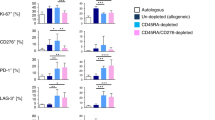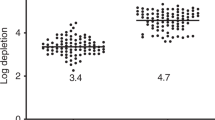Abstract
In allo-stem cell transplantation (SCT), it is unclear whether donor-specific anti-HLA Abs (DSAs) can actually mediate graft rejection or if they are simply surrogate markers for the cellular immunity that causes graft rejection. Here, we first analyzed a case of cord blood allograft rejection in which DSA and cytotoxic T lymphocyte (CTL) specific for donor HLA-B*54:01 were detected at the time of graft rejection. Both the DSA and CTL inhibited colony formation by unrelated bone marrow mononuclear cells sharing HLA-B*54:01, suggesting that the humoral and cellular immune responses were involved in the graft rejection. Interestingly, the DSA and CTL were also detected in cryopreserved pre-transplant patient blood, raising a hypothesis that the presence of anti-HLA Abs could be an indicator for corresponding HLA-specific T cells. We then evaluated the existence of HLA-specific CD8+ T cells in other patient blood specimens having anti-HLA class I Abs. Interferon-γ enzyme-linked immunospot assays clearly confirmed the existence of corresponding HLA-specific T-cell precursors in three of seven patients with anti-HLA Abs. In conclusion, our data demonstrate that integrated humoral and cellular immunity recognizing the same alloantigen of the donor can mediate graft rejection in DSA-positive patients undergoing HLA-mismatched allo-SCT. Further studies generalizing our observation are warranted.
This is a preview of subscription content, access via your institution
Access options
Subscribe to this journal
Receive 12 print issues and online access
$259.00 per year
only $21.58 per issue
Buy this article
- Purchase on Springer Link
- Instant access to full article PDF
Prices may be subject to local taxes which are calculated during checkout




Similar content being viewed by others
References
Olsson R, Remberger M, Schaffer M, Berggren DM, Svahn BM, Mattsson J et al. Graft failure in the modern era of allogeneic hematopoietic SCT. Bone Marrow Transplant 2013; 48: 537–543.
Rocha V, Labopin M, Sanz G, Arcese W, Schwerdtfeger R, Bosi A et al. Transplants of umbilical-cord blood or bone marrow from unrelated donors in adults with acute leukemia. N Engl J Med 2004; 351: 2276–2285.
Laughlin MJ, Eapen M, Rubinstein P, Wagner JE, Zhang MJ, Champlin RE et al. Outcomes after transplantation of cord blood or bone marrow from unrelated donors in adults with leukemia. N Engl J Med 2004; 351: 2265–2275.
Bierer BE, Emerson SG, Antin J, Maziarz R, Rappeport JM, Smith BR et al. Regulation of cytotoxic T lymphocyte-mediated graft rejection following bone marrow transplantation. Transplantation 1988; 46: 835–839.
Kernan NA, Flomenberg N, Dupont B, O’Reilly RJ . Graft rejection in recipients of T-cell-depleted HLA-nonidentical marrow transplants for leukemia. Identification of host-derived antidonor allocytotoxic T lymphocytes. Transplantation 1987; 43: 842–847.
Mattsson J, Ringden O, Storb R . Graft failure after allogeneic hematopoietic cell transplantation. Biol Blood Marrow Transplant 2008; 14 (Supplement 1): 165–170.
Storb R . B cells versus T cells as primary barrier to hematopoietic engraftment in allosensitized recipients. Blood 2009; 113: 1205.
Voogt PJ, Fibbe WE, Marijt WA, Goulmy E, Veenhof WF, Hamilton M et al. Rejection of bone-marrow graft by recipient-derived cytotoxic T lymphocytes against minor histocompatibility antigens. Lancet 1990; 335: 131–134.
Fleischhauer K, Kernan NA, O’Reilly RJ, Dupont B, Yang SY . Bone marrow-allograft rejection by T lymphocytes recognizing a single amino acid difference in HLA-B44. N Engl J Med 1990; 323: 1818–1822.
Fleischhauer K, Zino E, Mazzi B, Sironi E, Servida P, Zappone E et al. Peripheral blood stem cell allograft rejection mediated by CD4(+) T lymphocytes recognizing a single mismatch at HLA-DP beta 1*0901. Blood 2001; 98: 1122–1126.
Narimatsu H, Murata M, Terakura S, Sugimoto K, Naoe T . Potential role of a mismatched HLA-specific CTL clone developed pre-transplant in graft rejection following cord blood transplantation. Biol Blood Marrow Transplant 2008; 14: 397–402.
Pei J, Akatsuka Y, Anasetti C, Lin MT, Petersdorf EW, Hansen JA et al. Generation of HLA-C-specific cytotoxic T cells in association with marrow graft rejection: analysis of alloimmunity by T-cell cloning and testing of T-cell-receptor rearrangements. Biol Blood Marrow Transplant 2001; 7: 378–383.
Eng HS, Bennett G, Chang SH, Dent H, McDonald SP, Bardy P et al. Donor human leukocyte antigen specific antibodies predict development and define prognosis in transplant glomerulopathy. Hum Immunol 2011; 72: 386–391.
Reinsmoen NL, Nelson K, Zeevi A . Anti-HLA antibody analysis and crossmatching in heart and lung transplantation. Transpl Immunol 2004; 13: 63–71.
Terasaki PI . A personal perspective: 100-year history of the humoral theory of transplantation. Transplantation 2012; 93: 751–756.
Arias M, Rush DN, Wiebe C, Gibson IW, Blydt-Hansen TD, Nickerson PW et al. Antibody-mediated rejection: analyzing the risk, proposing solutions. Transplantation 2014; 98 (Suppl 3): S3–S21.
Ciurea SO, Thall PF, Wang X, Wang SA, Hu Y, Cano P et al. Donor-specific anti-HLA Abs and graft failure in matched unrelated donor hematopoietic stem cell transplantation. Blood 2011; 118: 5957–5964.
Costa LJ, Moussa O, Bray RA, Stuart RK . Overcoming HLA-DPB1 donor specific antibody-mediated haematopoietic graft failure. Br J Haematol 2010; 151: 94–96.
Cutler C, Kim HT, Sun L, Sese D, Glotzbecker B, Armand P et al. Donor-specific anti-HLA antibodies predict outcome in double umbilical cord blood transplantation. Blood 2011; 118: 6691–6697.
Ruggeri A, Rocha V, Masson E, Labopin M, Cunha R, Absi L et al. Impact of donor-specific anti-HLA antibodies on graft failure and survival after reduced intensity conditioning-unrelated cord blood transplantation: a Eurocord, Societe Francophone d’Histocompatibilite et d’Immunogenetique (SFHI) and Societe Francaise de Greffe de Moelle et de Therapie Cellulaire (SFGM-TC) analysis. Haematologica 2013; 98: 1154–1160.
Spellman S, Bray R, Rosen-Bronson S, Haagenson M, Klein J, Flesch S et al. The detection of donor-directed, HLA-specific alloantibodies in recipients of unrelated hematopoietic cell transplantation is predictive of graft failure. Blood 2010; 115: 2704–2708.
Takanashi M, Atsuta Y, Fujiwara K, Kodo H, Kai S, Sato H et al. The impact of anti-HLA antibodies on unrelated cord blood transplantations. Blood 2010; 116: 2839–2846.
Brunstein CG, Noreen H, DeFor TE, Maurer D, Miller JS, Wagner JE . Anti-HLA antibodies in double umbilical cord blood transplantation. Biol Blood Marrow Transplant 2011; 17: 1704–1708.
Detrait M, Dubois V, Sobh M, Morisset S, Tedone N, Labussiere H et al. Impact of anti-HLA antibodies on allogeneic hematopoietic stem cell transplantation outcomes after reduced-intensity conditioning regimens. Exp Hematol 2012; 40: 792–799.
Ciurea SO, de Lima M, Cano P, Korbling M, Giralt S, Shpall EJ et al. High risk of graft failure in patients with anti-HLA antibodies undergoing haploidentical stem-cell transplantation. Transplantation 2009; 88: 1019–1024.
Ottinger HD, Rebmann V, Pfeiffer KA, Beelen DW, Kremens B, Runde V et al. Positive serum crossmatch as predictor for graft failure in HLA-mismatched allogeneic blood stem cell transplantation. Transplantation 2002; 73: 1280–1285.
Focosi D, Zucca A, Scatena F . The role of anti-HLA antibodies in hematopoietic stem cell transplantation. Biol Blood Marrow Transplant 2011; 17: 1585–1588.
Nordlander A, Uhlin M, Ringden O, Kumlien G, Hauzenberger D, Mattsson J . Immune modulation to prevent antibody-mediated rejection after allogeneic hematopoietic stem cell transplantation. Transpl Immunol 2011; 25: 153–158.
Yoshihara S, Taniguchi K, Ogawa H, Saji H . The role of HLA antibodies in allogeneic SCT: is the ‘type-and-screen’ strategy necessary not only for blood type but also for HLA? Bone Marrow Transplant 2012; 47: 1499–1506.
Yoshihara S, Maruya E, Taniguchi K, Kaida K, Kato R, Inoue T et al. Risk and prevention of graft failure in patients with preexisting donor-specific HLA antibodies undergoing unmanipulated haploidentical SCT. Bone Marrow Transplant 2012; 47: 508–515.
Barge AJ, Johnson G, Witherspoon R, Torok-Storb B . Antibody-mediated marrow failure after allogeneic bone marrow transplantation. Blood 1989; 74: 1477–1480.
Fang JP, Xu LH, Yang XG, Wu YF, Weng WJ, Xu HG . Panel reactive antibody in thalassemic serum inhibits proliferation and differentiation of cord blood CD34+ cells in vitro. Pediatr Hematol Oncol 2009; 26: 338–344.
Murata M, Warren EH, Riddell SR . A human minor histocompatibility antigen resulting from differential expression due to a gene deletion. J Exp Med 2003; 197: 1279–1289.
Sugimoto K, Murata M, Terakura S, Naoe T . CTL clones isolated from an HLA-Cw-mismatched bone marrow transplant recipient with acute graft-versus-host disease. J Immunol 2009; 183: 5991–5998.
Kato T, Terakura S, Murata M, Sugimoto K, Murase M, Iriyama C et al. Escape of leukemia blasts from HLA-specific CTL pressure in a recipient of HLA one locus-mismatched bone marrow transplantation. Cell Immunol 2012; 276: 75–82.
Puisieux I, Even J, Pannetier C, Jotereau F, Favrot M, Kourilsky P . Oligoclonality of tumor-infiltrating lymphocytes from human melanomas. J Immunol 1994; 153: 2807–2818.
van Heijst JW, Ceberio I, Lipuma LB, Samilo DW, Wasilewski GD, Gonzales AM et al. Quantitative assessment of T cell repertoire recovery after hematopoietic stem cell transplantation. Nat Med 2013; 19: 372–377.
Li S, Lefranc MP, Miles JJ, Alamyar E, Giudicelli V, Duroux P et al. IMGT/HighV QUEST paradigm for T cell receptor IMGT clonotype diversity and next generation repertoire immunoprofiling. Nat Commun 2013; 4: 2333.
Barrett AJ, Faille A, Saal F, Balitrand N, Gluckman E . Marrow graft rejection and inhibition of growth in culture by serum in aplastic anaemia. J Clin Pathol 1978; 31: 1244–1248.
Brand A, Doxiadis IN, Roelen DL . On the role of HLA antibodies in hematopoietic stem cell transplantation. Tissue Antigens 2013; 81: 1–11.
Parker DC . T cell-dependent B cell activation. Annu Rev Immunol 1993; 11: 331–360.
Conlon TM, Saeb-Parsy K, Cole JL, Motallebzadeh R, Qureshi MS, Rehakova S et al. Germinal center alloantibody responses are mediated exclusively by indirect-pathway CD4 T follicular helper cells. J Immunol 2012; 188: 2643–2652.
Ott PA, Berner BR, Herzog BA, Guerkov R, Yonkers NL, Durinovic-Bello I et al. CD28 costimulation enhances the sensitivity of the ELISPOT assay for detection of antigen-specific memory effector CD4 and CD8 cell populations in human diseases. J Immunol Methods 2004; 285: 223–235.
Koyama M, Hashimoto D, Nagafuji K, Eto T, Ohno Y, Aoyama K et al. Expansion of donor-reactive host T cells in primary graft failure after allogeneic hematopoietic SCT following reduced-intensity conditioning. Bone Marrow Transplant 2014; 49: 110–115.
Ottmann OG, Nocka KH, Moore MA, Pelus LM . Differential expression of class II MHC antigens in subpopulations of human hematopoietic progenitor cells. Leukemia 1988; 2: 677–686.
Shiratori S, Ito M, Yoneoka M, Hayasaka K, Hayase E, Iwasaki J et al. Successful engraftment in HLA-mismatched bone marrow transplantation despite the persistence of high-level donor-specific anti-HLA-DR antibody. Transplantation 2013; 96: e34–e44.
Donohue J, Homge M, Kernan NA . Characterization of cells emerging at the time of graft failure after bone marrow transplantation from an unrelated marrow donor. Blood 1993; 82: 1023–1029.
Taylor PA, Ehrhardt MJ, Roforth MM, Swedin JM, Panoskaltsis-Mortari A, Serody JS et al. Preformed antibody, not primed T cells, is the initial and major barrier to bone marrow engraftment in allosensitized recipients. Blood 2007; 109: 1307–1315.
Xu H, Chilton PM, Tanner MK, Huang Y, Schanie CL, Dy-Liacco M et al. Humoral immunity is the dominant barrier for allogeneic bone marrow engraftment in sensitized recipients. Blood 2006; 108: 3611–3619.
Acknowledgements
We thank Chika Wakamatsu and Yoko Matsuyama for their technical assistance. This work was supported in part by a grant (H25-Immunology-104 and H26-Immunology-106) from the Ministry of Health, Labor and Welfare, Japan and a Grant-in-Aid for Scientific Research (no. 23591415) from the Ministry of Education, Culture, Sports, Science and Technology of Japan.
Author contributions
RH and M Murata designed the study, performed the primary experiments, analyzed the data and wrote the paper. KS and M Murase prepared clinical samples, performed research and analyzed the data. RS, TG, KW, NI, HO and YA performed research. SK and KM prepared clinical samples. ST, HK, T Nishida and T Naoe contributed to the discussion and helped write the paper.
Author information
Authors and Affiliations
Corresponding author
Ethics declarations
Competing interests
The authors declare no conflict of interest.
Additional information
Supplementary Information accompanies this paper on Bone Marrow Transplantation website
Supplementary information
Rights and permissions
About this article
Cite this article
Hanajiri, R., Murata, M., Sugimoto, K. et al. Integration of humoral and cellular HLA-specific immune responses in cord blood allograft rejection. Bone Marrow Transplant 50, 1187–1194 (2015). https://doi.org/10.1038/bmt.2015.119
Received:
Revised:
Accepted:
Published:
Issue Date:
DOI: https://doi.org/10.1038/bmt.2015.119



